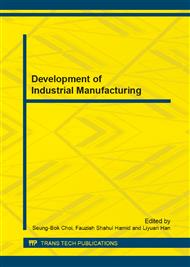p.108
p.117
p.123
p.128
p.133
p.141
p.146
p.150
p.154
Heat Capacities and Standard Molar Enthalpy of Formation of Butyl 4-Hydroxybenzoate (C11H14O3)
Abstract:
Low-temperature heat capacities of butyl 4-hydroxybenzoate have been measured by a high precision automated adiabatic calorimeter over the temperature range from 79 to 399 K. The melting temperature, the molar enthalpy and entropy of the phase transition were determined to be (342.227 ± 0.054) K, (26.122 ± 0.192) kJmol-1 and (76.33 ± 0.55) JK-1mol-1.The thermodynamic functions (HT -H298.15K) and (ST- S298.15K) were calculated in the range from 80 to 400 K with the interval of 5 K. The constant-volume energy and standard molar enthalpy of combustion have been determined, cU (C11H14O3,s) =-(5760.30 ± 2.70) kJmol-1 and cHm0 (C11H14O3, s) =-(5765.26 ± 2.70) kJmol-1, by means of a precision oxygen-bomb combustion calorimeter at T = 298.15 K. The standard molar enthalpy of formation has been derived, fHm0 (C11H14O3, s) =-( 564.16 ± 4.41) kJmol-1, from the standard molar enthalpy of combustion in combination with other auxiliary thermodynamic quantities through a Hess thermochemical cycle.
Info:
Periodical:
Pages:
133-140
Citation:
Online since:
February 2014
Authors:
Price:
Сopyright:
© 2014 Trans Tech Publications Ltd. All Rights Reserved
Share:
Citation:


